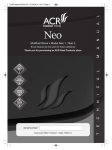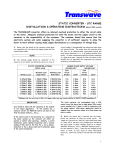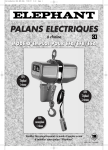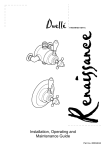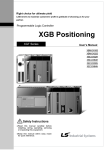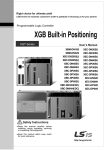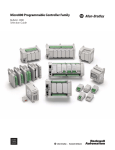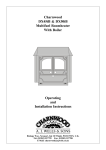Download ACR Heat The Buxton BX1MF Specifications
Transcript
TECHNICAL MANUAL
The Buxton
Multifuel Stove
Model BX1MF
To be retained by the user for future reference
Serial Number …………………………….
Version 1Date 17/10/2013
Document BX1MF 0101
Thank you for purchasing an ACR Heat Products stove.
To ensure that you gain the most from your purchase, please take a few
minutes to read through this manual before lighting the appliance for the
first time.
SINCE APRIL 2002 ONLY REGISTERED COMPETENT INSTALLERS CAN INSTALL
SOLID FUEL APPLIANCES. INSTALLATIONS CARRIED OUT BY NON-REGISTERED
INSTALLERS MUST BE INSPECTED BY LOCAL AUTHORITY BUILDING CONTROL.
FOR MORE INFORMATION PLEASE CONTACT HETAS AT;
www.hetas.co.uk OR TELEPHONE 0845 6345626
The installation of this appliance must comply with current Building
Regulations and local regulations, including those referring to
national and European standards need to be complied with when
installing the appliance.
Do not operate this appliance if it becomes damaged.
Improper use, maintenance or fitting parts other than those
approved by the manufacturer could lead to the appliance
becoming damaged or unsafe which in turn could lead to personal
injury or damage to the property and will void the warranty.
The appliance must not be modified in anyway unless authorized by
ACR Heat Products Ltd.
The appliance should be inspected regularly to ensure the airways
are clean and free from obstruction and the chimney swept at least
once a year.
The external surfaces of this appliance will be very hot to the touch
when in operation and due care will need to be taken when
operating the appliance to ensure safety. A fire guard that
complies to BS 8423:2002, should be fitted if it is likely that the elderly,
infirm or children may come into contact with the appliance.
This appliance must not be used as an incinerator.
This appliance has been designed for intermittent operation.
Before installation, please ensure that the correct model has been
supplied. Please also make a note of the serial number of your appliance
in the space provided on the front cover of this manual as this will be
requested if you require technical assistance in the future.
BUXTON SPECIFICATIONS
Nominal heat output ………… 7.2 kW – WOOD 7.5 kW – SMOKELESS FUEL
Chimney draft required ……… 12Pa
Height …………………………… 595 mm
Width ……………………………. 542 mm
Depth ………………………….... 415 mm
Weight …………………………… 80 kg
Direct Air Intake………………… 80mm
Air Requirement ……………….. 1375mm2
Flue Mass Gas Flow …………… 5.5g/s – WOOD 5.6g/s – SMOKELESS FUEL
Mean Flue Gas Temperature .. 315°C – WOOD 308°C - SMOKELESS FUEL
Efficiency ………………………... 78.6% - WOOD
77.4% - SMOKELESS FUEL
Log Length ………………………. Up To 400 mm
*** Please note that Building Regulations Document J advises that
additional air supply is required for appliances with an output of above
5Kw.
With modern properties additional air may be required as
Document J suggests that adequate air would be a benefit. If in doubt,
please consult your registered installer for advice.
NOTE: DO NOT INSTALL IN A ROOM CONTAINING AN EXTRACTOR FAN,
Buxton Dimensions
The Clean Air Act 1993 and Smoke Control Areas
Under the Clean Air Act local authorities may declare the whole or part of
the district of the authority to be a smoke control area. It is an offence to
emit smoke from a chimney of a building, from a furnace or from any
fixed boiler if located in a designated smoke control area. It is also an
offence to acquire an "unauthorized fuel" for use within a smoke control
area unless it is used in an "exempt" appliance ("exempted" from the
controls which generally apply in the smoke control area).
The Secretary of State for Environment, Food and Rural Affairs has powers
under the Act to authorize smokeless fuels or exempt appliances for use in
smoke control areas in England. In Scotland and Wales this power rests
with Ministers in the devolved administrations for those countries. Separate
legislation, the Clean Air (Northern Ireland) Order 1981, applies in Northern
Ireland. Therefore it is a requirement that fuels burnt or obtained for use in
smoke control areas have been "authorized" in Regulations and that
appliances used to burn solid fuel in those areas (other than "authorized"
fuels) have been exempted by an Order made and signed by the
Secretary of State or Minister in the devolved administrations.
The Buxton (BX1MF) has been recommended as suitable for use in smoke
control areas when burning wood, the manufactures permanent stop
MUST BE fitted to the secondary air slider..
Further information on the requirements of the Clean Air Act can be found
here : http://smokecontrol.defra.gov.uk/
Your local authority is responsible for implementing the Clean Air Act 1993
including designation and supervision of smoke control areas and you
can contact them for details of Clean Air Act requirements
Installation Instructions
CO Alarms
It is required by building regulations that whenever a new or replacement
wood/solid fuel or biomass appliance is installed in a dwelling a carbon
monoxide alarm to BS EN 50292:2002 must be fitted in the same room as
the appliance.
The alarm should be install according to the alarms manufacturers
instructions and should not be considered a substitute for the appliance
being installed incorrectly or regular maintenance of the appliance or flue
system
Location of the unit
Clearances to non-combustible materials
There must be a minimum clearance of 150mm at each side of the
appliance. A clearance of 150mm is required at the back of stove (if the
rear wall has a thickness of 200mm or more this measurement can be
reduced to 50mm) A minimum clearance of 150mm is required above the
appliance.
Clearances to combustible materials
There must be a minimum clearance of 600mm at each side and 750mm
at the rear of the appliance from any combustible materials. If using
single wall flue pipe, there must be a clearance of at least 3 times the
diameter of the flue pipe (e.g 125mm diameter pipe = 375mm minimum
clearance) from any combustible materials e.g wooden beam.
Curtains and soft furnishings should be a minimum of 1m away from the
appliance.
Adequate space should be provided for servicing the appliance.
We do not recommend that plasma televisions and expensive artwork are
hung over the fireplace.
Please remember that this appliance has been designed to provide heat
and if installed into a recess enough space should be left around the
appliance to enable the heat produced to rise and escape from the
recess back into the room.
Hearth Requirements
The appliance must stand on a level fireproof hearth with a minimum
thickness of 12mm. The hearth temperature created by this stove is below
100˚C. The hearth must protrude at least 300mm in front of the appliance
and 150mm either side of the appliance.
The appliance shall be installed on a floor with an adequate load bearing
capacity. If an existing construction doesn’t meet with prerequisite,
suitable measures (e.g. load distributing plate) shall be taken to achieve it.
Flue Requirements
The chimney must comply with current Building Regulations.
Provision
must be made to provide access for cleaning the appliance, the flue gas
connector and the chimney flue.
The flue must be:
In sound condition and provide sufficient draft (Min 12Pa)
Suitable for use with solid fuel burning appliances
Free from deposits
Well insulated
At least 4.5m in height
The flue must not be:
Shared with other appliances
Weight bearing on the appliance
A smaller diameter than the appliance flue collar size (125mm)
Assembly of the unit
If this unit is to be installed in a smoke controlled area the manufactures
permanent stop must be fitted to the secondary air control in all
circumstances.
To install the smoke exemption square,
Firstly fully open the secondary slider by pushing the handle fully to the
right
Insert the square into the far left of the secondary channel and tap into
place using a hammer or other suitable tool
The square is correctly fitted when it is flush with the front casing
The smoke exemption square should be fitted by a competent person as
part of the original commissioning process and once installed should not
be removed.
The appliance is supplied assembled with the flue spigot in the top exit
position.
If you intend to install the appliance using a rear flue connection, the
blanking plate should be swapped over as follows:
Remove the internal baffle plate
Remove the blanking plate retaining bar internally.
Remove the flue spigot from the top exit by removing the securing
bolts and rope seal.
Refit the rope seal and flue spigot to the rear exit and secure with the
bolts. Seal with fire cement.
Refit the blanking plate to the top exit using the rope seal and retaining
bolts.
You may remove the rear air intake spigot if not using the direct air kit
Maintenance
The chimney should be swept at least once a year together with the flue
pipe connection. Care should be taken to ensure that there is not a build
up of soot on the baffle and in the airways of the appliance.
If the appliance has not been operated for long periods, the flue should
be inspected and swept before use to ensure there are no blockages
within the flue.
The grate should be cleaned regularly and the ashpan emptied daily.
NEVER ALLOW THE ASH IN THE ASHPAN TO OVERFILL ALLOWING ASH TO BE
IN CONTACT WITH THE UNDERSIDE OF THE GRATE. This will overheat the
grate and cause premature wear and distortion.
The internal vermiculite panels of the appliance should be checked
regularly for soundness. If any wear and tear is found, we recommend
these parts are replaced immediately.
Check the rope door seals are intact and are not worn. These should be
replaced on an annual basis to ensure the correct operation of this
appliance.
The glass can be cleaned using a soft damp cloth and window cleaner or
ACR stove glass cleaner (available from your local stockist)
Use only replacement parts recommended by the manufacturer.
We recommend that the appliance is serviced annually by a competent
engineer to ensure it’s continued safe operation.
User Instructions
Please note that during the first firing, we recommend a small fire is lit and
that you slowly increase the temperature to enable the various parts to
expand normally.
You may also experience fumes and a haze being given off by the stove
during the first firing and possibly for the next couple of firings as the paint
cures. This is normal but please ensure that the room is well ventilated
during this period.
The appliance should not be operated in mild weather with smokeless
fuel. Under certain weather circumstances e.g. fog the chimney will not
draw sufficiently well and could cause asphyxiation. Either await better
weather or burn wood only.
In the rare event of a malfunction due to overheating or a chimney fire,
the air slides should be shut down completely and the fuel allowed to
burn out. In the event of a chimney fire, once the air slides have been
closed completely, dial 999 for assistance. If the appliance has
overheated, the appliance will need to be inspected for any damage
before it can be operated again.
Recommended Fuels
Wood – hardwood such as ash, oak and beech which have been cut for
at least 2 years and stored under shelter. The logs should have a
maximum moisture content of 20% and a maximum log length of 400mm.
Smokeless Fuels – such as Anthracite, Phurnacite & Ancit
Prohibited Fuels
Green wood – i.e wood which is less than 2 years old with a moisture
content of above 20%
Recovered wood – i.e pallets, railway sleepers etc. These will have been
chemically treated and will pollute the atmosphere and possibly overheat
the appliance.
Housecoal or Bituminous coal – these fuels will soot up the airways of the
stove and possibly overheat the appliance.
Petroleum Based Coke – this will overheat the appliance and possibly
damage the unit. (Not above 20% Pet coke content)
Any form of liquid fuels.
Instructions for use with wood
Slide the top air control to the right and pull open the primary air fully.
Lay firelighters or rolled up newspapers on the grate and add a small
amount of kindling wood to the top. Place 1 or 2 small logs on the top.
Light the newspaper or firelighters using a long taper and push the
door to.
When the fire is burning fiercely, after a couple of minutes add more
logs and close the door.
When the fire has become established, close the primary air down.
The burning rate can be altered by moving the top air slide.
Care should be taken to ensure that the logs are not placed higher
than the log guard allows.
The air controls should not be adjusted except as directed in these
instructions
Instructions for use with smokeless fuel
Slide the top air control to the right and open the primary air fully, fully
close the tertiary air tabs at the rear of the appliance.
Lay firelighters or rolled up newspapers on the grate and add a small
amount of kindling wood to the top. Place a small quantity of
smokeless fuel on top.
Light the newspaper or firelighters using a long taper and push the
door to.
When the fire is burning fiercely, after a couple of minutes add more
smokeless fuel and close the door.
When the fire has become established, close the top air down.
The burning rate can be altered by moving the primary air slide.
Care should be taken to ensure that the firebox is not overfilled with
smokeless fuel – it should be no higher than the log guard.
Re-fueling
When refueling the stove always refuel onto a bed of hot embers, fully
open the secondary air control and leave the door slightly ajar for a few
minutes or until the new fuel is well alight, before closing the door and
adjusting the air controls for the desired setting.
If there is insufficient burning material in the firebed to light a new fuel
charge, excessive smoke emission can occur. Refueling must be carried
out onto a sufficient quantity of glowing embers and ash that the new fuel
charge will ignite in a reasonable period. If there are too few embers in
the fire bed, add suitable kindling to prevent excessive smoke.
Never overload the stove – it will work very well with two medium sized
logs. The amount of fuel specified in this manual should not be exceeded,
overloading can cause excess smoke.
Operation with door left open
Operation with the door open can cause excess smoke. The appliance
must not be operated with the appliance door left open except as
directed in the instructions.
Dampers left open
Operation with the air controls or appliance dampers open fully can
cause excess smoke. The appliance must not be operated with air
controls, appliance dampers or door left open except as directed in the
instructions.
Never leave the stove unattended until the new fuel is well alight.
Persistent fume emission is dangerous and must be investigated.
If fume emission persists, open doors and windows to ventilate the room
and let the fire dies out. Have the chimney inspected for blockages and
clean if required. Do not relight the fire until the cause has been found.
We recommend that you seek professional advice.
This appliance has been designed to be burned with the door closed at
all times other than when refueling. It should not be operated as an open
fire.
Typical refueling intervals for wood is 1 hour and smokeless fuel is 2 hours.
Daily Maintenance
The ashpan should be checked and emptied regularly.
You should never allow the ashes in the pan to build up to the level of the
grate.
If they are allowed to build up, the grate will become sandwiched
between the ash below it and above it.
This will overheat the grate and cause distortion and premature wear.
Troubleshooting
Problem
Probable Cause
Action Recommended
Fire difficult to
Start / Fire goes
Out
Green wood / wet wood
Use hardwood logs
with a maximum
moisture content of 20%
Logs are too large
Use small logs to start
The fire and once
Established use split logs
Not enough primary air
Open air control
Insufficient draft
Check the flue is not
Obstructed
Too much draft
Reduce the air control
Excessive draft
Install a draft stabiliser
Smokes on initial
Lighting
Flue is cold
Burn paper and kindling
to increase heat in flue
Smokes while
Burning
Insufficient draught
Check the flue is not
obstructed
Fire burns too
Quickly
Low heat output Poor quality wood
Use seasoned
Hardwood (this has a
Higher calorific value)
SPAREPART LIST
STOVE-K4301 BUXTON
Position Quantity Description
1.
1
burning chamber door complete
2.
1
hinge
3.
1
flue spigot
4.
2
flue spigot gasket (8x3)
5.
4
leg
6.
1
airbox cover cap
7.
1
heat protection plate
8.
4
distance piece
9.
1
primary air regulator
10.
1
linea spring
11.
1
door cover plate
12.
4
adjustable feet
13.
1
air socket
14.
1
tertiary regulation plate left
15.
1
tertiary regulation plate right
16.
1
ash pan
17.
1
grate frame
18.
1
log guard rail right
19.
1
log guard rail left
20.
1
riddling rod
21.
2
log guard
22.
1
oscillating grate
23.
1
back panel
24.
1
left vermiculite brick
25.
1
right vermiculite brick
26.
1
baffle plate
27.
1
secondary airbox
28.
2
linear spring
29.
1
cover plate
30.
1
fixing plate
31.
1
distance plate
32.
1
secondary air regulator
33.
1
blanking plate
34.
1
cast iron door
35.
1
door handle
36.
1
locking rod door handle
37.
1
door rope (D10)
38.
1
glass gasket (8x3)
39.
4
glass retaining brackets
40.
1
glass
Vermiculite set
Fireplace number
8400-315
5136-414
3490-047
1982-004
9900-1258B
3811-551A
4811-305B
7922-011
5311-588B
6536-018
9900-993
4300-949
9900-1005B
5111-410
5111-411
9900-1027A
4290-1273
7911-1212
7911-1211
9900-1028B
4290-1276A
4290-1201A
4290-1274
6081-773A
6081-774B
3711-172
9900-1122
6536-018
5311-629
5311-631
5311-630
5311-590D
4111-136
4490-1386
9900-1142
5035-405
1982-012
1982-004
6612-241
5540-313
9900-1138
Commissioning Check List
(Please mark box when completed)
Ensure the serial number has been recorded on the front of this manual for
any future use
Ensure the door seals are in good condition and that the glass is secured
correctly in the door (do not over tighten the glass as this will prohibit its
expansion and could cause the glass to crack)
Ensure that all internal components are fitted correctly (these may have
shifted in transit)
Ensure that the appliance operates correctly during the first firing
Ensure the customer is aware that fumes may be given off during the first
firings as the paint cures
Advise the customer on the safe operation of the appliance
Leave the instruction manuals, operating tool and glove for the
customer’s use.
Warranty Certificate
The specifications within this document are provided for information
purposes only and are under no circumstances binding.
With the aim of constantly improving our products, all modifications
considered necessary may be made without notice.
Our appliances are guaranteed against faults and hidden defects subject
to the following conditions:
The appliance must have been installed by a registered competent
installer (HETAS) or inspected by local authority Building Control
The appliance must be installed and operated in accordance with our
instruction manual
The guarantee is for a period of 5 years on the appliance body from
the date of purchase
The following components are considered as consumables and are
excluded from the guarantee:
Grates
Rope seals
Ashpan
Internal vermiculite panels
Glass
Baffle plates
Your statutory rights are not affected by this warranty.
In the event of a warranty claim, please return the form overleaf to
ACR Heat Products Ltd, Unit One, Weston Works, Weston Lane, Tyseley,
Birmingham, B11 3RP, UK.
Warranty Claim Form
Customer Name: ………………………………………………………………………
Customer Address: …………………………………………………………………….
………………………………………………………………………………………………
……………………………………………………………. Postcode ………………….
Daytime Tel: ……………………………. Mobile Tel: ………………………………
Model Name: …………………………… Model Number: ……………………….
Serial Number: ………………………………………………………………………….
Date of purchase: ……………………………………………………………………..
Date of installation: ……………………………………………………………………
Installer’s Name and address: ………………………………………………………
………………………………………………………………………………………………
………………………………………………………………………………………………
Installer’s Registration Number: ……………………………………………………..
Building Control Certificate Number (if not installed by a registered
competent installer): ………………………………………………………………….
Dealer Name and address: ………………………………………………………….
………………………………………………………………………………………………
………………………………………………………………………………………………
Unit One Weston Works, Weston Lane, Tyseley, Birmingham, B11 3RP. UK
Tel: 0121 706 8266 Fax: 0121 706 9182
Email: [email protected]




















